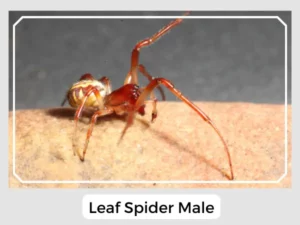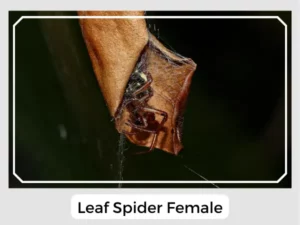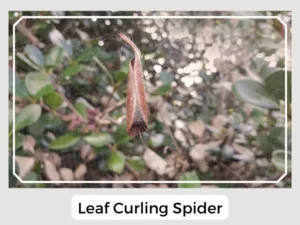Guess what? There’s a spider called the leaf or leaf curling spider. It loves to weave webs in certain parts of Australia. The fun part? This spider hides in a curled-up leaf right in the center of its web! That’s how it got its name.
The eggs are laid within a curled leaf suspended at a distance from the foliage.
The juvenile spiders begin to bend over a small-sized green leaf and eventually move on to bigger ones.
The web of these spiders can be identified in an easy way which has a diameter of about 30 cm. It is in the shape of an incomplete circle, open at the upper part and fanning in a downward direction.
Yes, Leaf Spiders are venomous. They use their venom to catch tasty insects for food, but it’s not very harmful to humans.
Yes, Leaf curling Spiders can bite. They’re usually busy in their webs, but if they do bite, it feels like a little pinch and isn’t harmful for most folks.

Photo Credit: Iain R Macaulay
Leaf Curling Spiders are important biological control agents. By preying on flying insects, they help to regulate insect populations, contributing to the health of their habitats. They are diurnal, remaining active during the day and using their curled leaves as shields against predators and environmental elements.
Natural Predators: Birds and parasitic wasps are among the Leaf Curling Spider’s natural predators. These predators help maintain a balance within the ecosystem, ensuring that spider populations do not become too large and disrupt the ecological equilibrium.
Prey-Predator Dynamics: The relationship between Leaf Curling Spiders and their prey is a classic predator-prey interaction within their environment. They control the insect population, while also providing nourishment for their predators, maintaining a healthy balance in the food web.
Relationship with Humans: Leaf Curling Spiders are generally harmless to humans. While they are venomous, their bites are rare and typically result in no more than minor discomfort. They often go unnoticed by humans due to their cryptic lifestyle and can be found in both natural and suburban gardens where they continue their role as pest controllers.
| Other Names | Leaf Curling spider |
| Distribution | Eastern, southern, north-eastern states of Australia |
| Habitat | Open woodland, forest, as well as gardens in suburban and urban regions |
| Diet | Flying insects |
| Predators | Birds, parasitic wasps |
| Lifespan | Approximately 1 year |

Photo Credit: David Nice
In summary, the Leaf Curling Spider is a remarkable example of adaptation and ecological significance.

Guess what? There’s a spider called the leaf or leaf curling spider. It loves to weave webs in certain parts of Australia. The fun part? This spider hides in a curled-up leaf right in the center of its web! That’s how it got its name.
The eggs are laid within a curled leaf suspended at a distance from the foliage.
The juvenile spiders begin to bend over a small-sized green leaf and eventually move on to bigger ones.
The web of these spiders can be identified in an easy way which has a diameter of about 30 cm. It is in the shape of an incomplete circle, open at the upper part and fanning in a downward direction.
Yes, Leaf Spiders are venomous. They use their venom to catch tasty insects for food, but it’s not very harmful to humans.
Yes, Leaf curling Spiders can bite. They’re usually busy in their webs, but if they do bite, it feels like a little pinch and isn’t harmful for most folks.

Photo Credit: Iain R Macaulay
Leaf Curling Spiders are important biological control agents. By preying on flying insects, they help to regulate insect populations, contributing to the health of their habitats. They are diurnal, remaining active during the day and using their curled leaves as shields against predators and environmental elements.
Natural Predators: Birds and parasitic wasps are among the Leaf Curling Spider’s natural predators. These predators help maintain a balance within the ecosystem, ensuring that spider populations do not become too large and disrupt the ecological equilibrium.
Prey-Predator Dynamics: The relationship between Leaf Curling Spiders and their prey is a classic predator-prey interaction within their environment. They control the insect population, while also providing nourishment for their predators, maintaining a healthy balance in the food web.
Relationship with Humans: Leaf Curling Spiders are generally harmless to humans. While they are venomous, their bites are rare and typically result in no more than minor discomfort. They often go unnoticed by humans due to their cryptic lifestyle and can be found in both natural and suburban gardens where they continue their role as pest controllers.
| Other Names | Leaf Curling spider |
| Distribution | Eastern, southern, north-eastern states of Australia |
| Habitat | Open woodland, forest, as well as gardens in suburban and urban regions |
| Diet | Flying insects |
| Predators | Birds, parasitic wasps |
| Lifespan | Approximately 1 year |

Photo Credit: David Nice
In summary, the Leaf Curling Spider is a remarkable example of adaptation and ecological significance.
